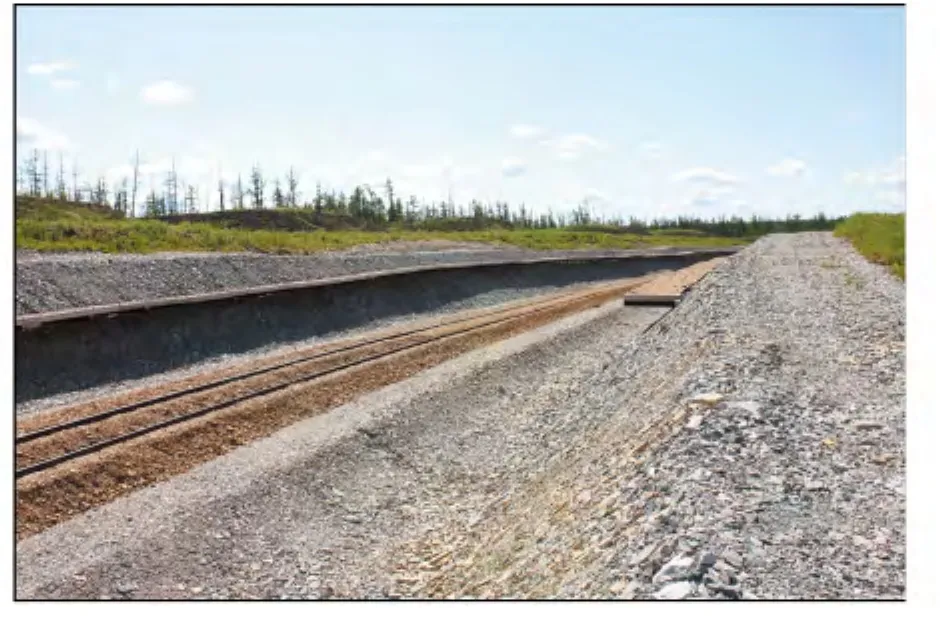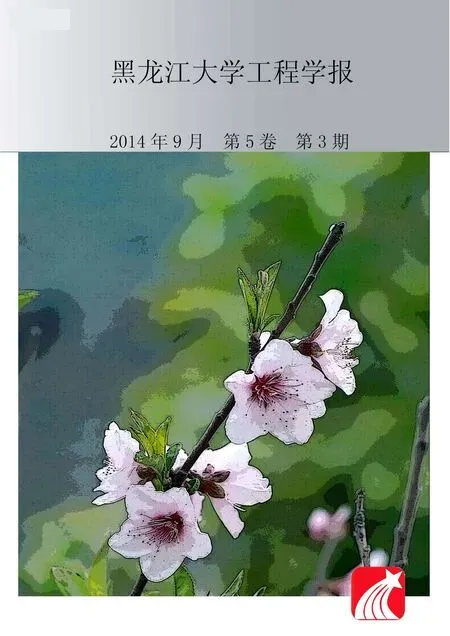新技术在阿穆尔-雅库茨克铁路干线施工中的应用
Shesternev D.M.,Litovko A.V.,Chzhan A.A.
(俄罗斯科学院西伯利亚分院麦尔尼科夫冻土研究所,雅库茨克677010,俄罗斯)
0 Introduction
Now the construction of the Amur-Yakutsk Mainline(AYaM)from Berkakit to Tommot to Nizhny Bestyakh has been completed.The AYaM runs for over 800 km from south to north,almost in a submeridional direction.In essence,the mainline is the first stage of the planned Transcontinental Railway across the Bering Strait.The construction of the second stage is now impossible in the direction of the Bering Strait due to the lack of a railway bridge across the Lena River and towards Magadan due to the reconstruction and construction of the Kolyma Federal Highway.An important task today is to develop a standard engineering-geocryological monitoring program for diagnostics and control of the railway system interaction with the environment,including permafrost,to providing effective construction,operation and maintenance of the AYaM.
1 Materials and methods
The stability of the Berkakit-Tommot-Nizhny Bestyakh railway is to a certain degree dependent on the stability of permafrost in its base.Besides the temperature,the permafrost ice content significantly affects its stability,which,as it is known,increases to the north.The railway section between 670~750 km is characterized by the most complicated geocryological conditions,according to the data of Melnikov Permafrost Institute and geotechnical investigations conducted by“Mosgiprotrans”,“Uralgiprotrans”,“YuzhYakut-TISIZ”,and other organizations.This section of the railway is underlain by the ice complex,with ice contents reaching 50% ~60%[1].
The railway geocryological structure can be briefly described as:
-Permafrost is continuous in the northern part of the Amga Plateau(530~630 km),on the Ust-Maya Plateau(630~700 km)and on the Lena river terraces (700~818 km);
-Permafrost thickness is 100~300 m or more,reaching 400~500 m in the northern part of the route;
-Mean annual temperatures here decrease northward from -1~-7℃;
-In other parts of the railway,permafrost is intermediate,discontinuous and insular with the thickness of 20~30 m to 100~200 m;
-Discontinuous permafrost is typical for the Chulman Plateau(0~130 km),the Aldan Plateau(130~294 km)and the Middle-Amga Plateau(386~530 km),where the mean annual ground temperature is from -1 to-3℃.
The necessity to create an individual construction plan for certain sections,where passive construction methods in permafrost were used,arose due to complex and non-uniform geocryologicalconditions ofthe AYaM.To the greatest extent this was done in the area,where the railway traverses the ice complex.The“Proekttransstroy”LLC together with the Melnikov Permafrost Institute,Central Research Institute and TransIGEM using developments of Moscow State University of Railway Engineering(MIIT)and experience of construction and operation of railways in Russia and abroad have developed the roadbed of AYaM.
Measures to prevent permafrost degradation beneath the embankments included:1)vertical thermosyphons with polystyrene foam insulation in 39 sections (693~710 km,730 km)with the total length of 4.9 km(soils of the IV type of settlement);2)extruded polystyrene foam insulation with the thickness of 5 cm on the side slopes and berms(129 m long at 709 km); 3)overhanging solar screens on the side slopes(100 m long at 709 km);4)thermosyphons(100 m-longsection at 709 km).Measures#1,2,3,and 4 were used in the test sites with similar geocryological conditions.
The analysis of the effectiveness of the measures is presented below.The measures were estimated according to the data of engineering-geocryological monitoring,which was conducted from the beginning of the railway construction(end of the 20th century)[2].
Penoplex polystyrene insulation was extensively used in roadway construction over the ice-rich permafrost(Fig.1).

Fig.1 Penoplex laying
Penoplex boards were installed,for example,in the embankment and berm at kilometer post(KP) 693.2.In the winter of 2010/2011 thermosyphons were installed on the berms(Fig.2).
Since 2010 the ground beneath embankment has tended to cool.A stronger ground cooling is registered under the berm on the right side.Under the left berm a minor ground cooling was registered(Fig.3).
In August 2010 temperature observations in boreholes beneath the berms at KP 693.2 and 693.5 showed that the insulating effect depends on the depth of placement.The deeper Penoplex is placed,the lesser its insulating effect is.Thus,with insulation placed at a depth of 0.7 m at KP 693.5 the depth of seasonal thaw beneath the berm was 1.70 m,while placement at 1.1 m(KP 693.2)resulted in thaw depth of 1.95 m(Fig.4).

Fig.2 Instalation of thermosyphons(KP 693.2)

Fig.3 Changes in temperature isotherms and permafrost table beneath the embankment at KP 692.61-number of soil layer;the permafrost table:2-in 2007,3-in 2011,4-in 2013;temperature contours:5-on 23.09.2007,6-on 17.09.2011,7-on 30.08.2013;8-rock with≤10%fines;9-Penoplex insulation boards;10-thermosyphons;11-temperature borehole.

Fig.4 Changes in depth of thaw and ground temperature beneath the berms during insulation placement at different depths at KP 693.2 and 693.5.
The thermosyphons were put into operation in the winter of 2010/2011 on berms of the mentioned above kilometer posts.Three-year observations in boreholes located at varying distances from thermosyphons have indicated that their cooling effect is strong within 0.5 m radius(B-18)and is sharply reduced at a distance of 1.3 m(B-9)(Fig.5).Observations of following years also confirmed the similar effect.At KP 693.5 the permafrost table beneath the berm rose to the Penoplex placement level(0.7 m),whereas at KP 693.2 it remained at the same level(1.95 m).The positive effect of Penoplex and thermosyphons is also noticeable at KP 708.9.At KP 708.8,overhanging snow sheds/ solar screens were installed on the side slopes,2.5~3.0 m-high embankment(Fig.5).

Fig.5 Overhanging snow sheds/solar screens
During the first two winters the sufficient cooling effect was not achieved.In 2013 ground temperatures at 0.2 and 1.5 m beneath the centerline were-1.1 and-1.3℃ respectively.The permafrost table rose almost to the level of the natural ground surface.A minor ground cooling effect was registered beneath the right slope.The permafrost table is at a depth of 0.3~ 0.5 m from the natural surface.Beneath the left slope the permafrost table is at 1.0~1.3 m depth.Ground temperatures beneath the sideslopes shows a little change insignificantly.In 2011 thaw depth on a 2 m rock bank to the left of the embankment was about 2.2 m.Ground temperature at 10 m depth was-1.5℃.In 2012 and 2013,thaw depths estimated from temperature measurements were 2.7 m and 2.6 m respectively,while ground temperature increased to-1.1℃.At the toe of the left sideslope,seasonal thaw depth was 2.2~2.3 m and ground temperature was 1.2℃,indicating permafrost degradation in this area.
At KP 708.9,2.5 m high embankment with Penoplex board insulation and thermosyphons was constructed in 2010.After roadbed completion the only operating borehole beneath the left berm was preserved (Fig.7).In the winter of 2010/2011 there was a tendency in the ground thermal regime to cool due to the thermosyphons and the thermal insulation.

Fig.6 Changes in temperature isotherms and permafrost table beneath the embankment at KP 708.81-number of soil layer;the permafrost table:2-in 2008,3-in 2011,4-in 2013;temperature contours:5-on 26.08.2008,6-on 17.09.2011,7-on 31.08.2013;8-rock with≤10%fines;9-solar screen/snow shed;10-temperature borehole.

Fig.7 Changes in temperature isotherms and permafrost table beneath the embankment at KP 708.91–number of soil layer;the permafrost table:2-in 2008,3-in 2011;temperature contours:4-on 26.08.2008,5-on 17.09.2011;6-rock with≤10%fines;7-Penoplex insulation boards;8-thermosyphons;9-temperature borehole.
2 Condusions
In 2012/2013 ground temperatures beneath the berms preserved their tendency to cool.The permafrost table rose to the natural surface level.Ground temperature beneath the berm was-2.5℃ at 1.5 m depth in the end of the warm season[3].
The following conclusions can be made from the results:
1)The stability of the roadbed and engineering structures is affected by the temperature regime changes caused by controlled removal of water at edges of nonfilterable embankments.
2)Experimental monitoring investigations of berms have shown Penoplex effectiveness for improvement of railway characteristics in waterlogged areas.
3)The cooling effect of thermosyphons and Penoplex insulation is strong beneath the right berm and minor beneath the uphill side.Heat insulating effect of Penoplex depends on the depth of its placement.The cooling effect of thermosyphons is noticeable within 0.5 m radius and is sharply reduced at a distance of 1.3 m.The overhanging snow sheds/solar screens installed on the sideslopes of the 2.5~3.0 m high embankment have not had an expected cooling effect.
[1] Varlamov S P,Scriabin P N,Shender N I,et al.Permafrost conditions of the Tommot-Kerdem Railroad in the territory of the ice complex[J].Science and Eeducation,2006,44(4):78-83.
[2] Shesternev D M,Litovko A V.Geocryological problems of operation of the railway section“Berkakit—Tommot”/D.M.Shesternev,A.V.Litovko[A].Problems of Engineering Permafrost Studies.Materials of the IXth International Symposium[C].Yakutsk:Permafrost Institute SB RAS Press,2011:260-265.
[3] Shesternev D M,Varlamov S P,Scriabin P N,et al.Engineering and geocryological conditions of the“Berkakit-Tommot-Yakutsk”section of the AYaM[J].Scientific and Technical Report,2013,174-179.

